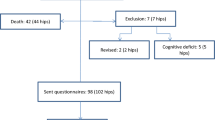Abstract
Objective
We aimed to correlate the preoperative importance of improvement and postoperative satisfaction in patients undergoing total hip replacement with the functional pre- and postoperative (12 months) status.
Method
Functional status was assessed by Western Ontario and McMasters Universities Osteoarthritis Index (WOMAC) and the preoperative importance was rated for all WOMAC and 13 items of daily living. The postoperative satisfaction was assessed alongside these 37 items.
Results
One hundred eighteen patients with a mean age of 59 (35–84) years (54% women) were included. Through surgery, WOMAC score increased from 39.5 to 78.6. Preoperative importance was high (73.1) and postoperative satisfaction was moderate to high (66.8). Younger patients were more satisfied (72.4 vs. 60.2, p = 0.02). After adjustment for age and gender, the preoperative functional status correlated significantly with the importance (β = 0.60, CI = 0.37–0.62), and so did postoperative functional status and satisfaction (β = −0.69, CI = −0.97 to −0.68). Satisfaction in WOMAC-related items correlated with the gain in WOMAC score (β = 0.35, CI = 0.16–0.45).
Conclusion
The high patient-rated importance of improvement and satisfaction are associated with age and gender and correlate with the corresponding functional status, i.e. its change.






Similar content being viewed by others
References
Gignac M, Davis A, Hawker G, Wright J, Mahomed N, Fortin P et al (2006) “What do you expect? You’re just getting older”: a comparison of perceived osteoarthritis-related and aging-related health experiences in middle- and older-age adults. Arthritis Rheum 55:905–912
Grotle M, Hagen K, Natvig B, Dahl F, Kvien T (2008) Prevalence and burden of osteoarthritis: results from a population survey in Norway. J Rheumatol 35:677–684
Roux C, Saraux A, Mazieres B, Pouchot J, Morvan J, Fautrel B et al (2008) Screening for hip and knee osteoarthritis in the general population: predictive value of a questionnaire and prevalence estimates. Ann Rheum Dis 67:1406–1411
Sun Y, Stürmer T, Günther K, Brenner H (1997) Inzidenz und Prävalenz der Cox- und Gonarthrose in der Allgemeinbevölkerung. Z Orthop Ihre Grenzgeb 135:184–192
Lawrence J, Bremner J, Bier F (1966) Osteo-arthrosis. Prevalence in the population and relationship between symptoms and X-ray changes. Ann Rheum Dis 25:1–24
Statistisches Bundesamt G (2007) Gesundheitsberichterstattung des Bundes, Bonn. www.gbe-bund.de
Mahomed N, Liang M, Cook E, Daltroy L, Fortin P, Fossel A et al (2002) The importance of patient expectations in predicting functional outcomes after total joint arthroplasty. J Rheumatol 29:1273–1279
Mason J (2008) The new demands by patients in the modern era of total joint arthroplasty: a point of view. Clin Orthop Relat Res 466:146–152
Mancuso C, Salvati E, Johanson N, Peterson M, Charlson M (1997) Patients’ expectations and satisfaction with total hip arthroplasty. J Arthroplasty 12:387–396
Noble P, Conditt M, Cook K, Mathis K (2006) The John Insall Award: patient expectations affect satisfaction with total knee arthroplasty. Clin Orthop Relat Res 452:35–43
Kiebzak G, Vain P, Gregory A, Mokris J, Mauerhan D (1997) SF-36 general health status survey to determine patient satisfaction at short-term follow-up after total hip and knee arthroplasty. J South Orthop Assoc 6:169–172
Fortin P, Clarke A, Joseph L, Liang M, Tanzer M, Ferland D et al (1999) Outcomes of total hip and knee replacement: preoperative functional status predicts outcomes at six months after surgery. Arthritis Rheum 42:1722–1728
Dieppe P, Judge A, Williams S, Ikwueke I, Guenther K, Floeren M et al (2009) Variations in the pre-operative status of patients coming to primary hip replacement for osteoarthritis in European orthopaedic centres. BMC Musculoskelet Disord 10:10–19
Bellamy N, Buchanan W, Goldsmith C, Campbell J, Stitt L (1988) Validation study of WOMAC: a health status instrument for measuring clinically important patient relevant outcomes to antirheumatic drug therapy in patients with osteoarthritis of the hip or knee. J Rheumatol 15:1833–1840
Stucki G, Meier D, Stucki S, Michel B, Tyndall A, Dick W et al (1996) Evaluation einer deutschen Version des WOMAC (Western Ontario and McMaster Universities) ArthroseIndex. Z Rheumatol 55:40–49
Haddad F, Garbuz D, Chambers G, Jagpal T, Masri B, Duncan C (2001) The expectations of patients undergoing revision hip arthroplasty. J Arthroplasty 16:87–91
Mancuso C, Sculco T, Salvati E (2003) Patients with poor preoperative functional status have high expectations of total hip arthroplasty. J Arthroplasty 18:872–878
Eisler T, Svensson O, Tengström A, Elmstedt E (2002) Patient expectation and satisfaction in revision total hip arthroplasty. J Arthroplasty 17:457–462
Moran M, Khan A, Sochart D, Andrew G (2003) Expect the best, prepare for the worst: surgeon and patient expectation of the outcome of primary total hip and knee replacement. Ann R Coll Surg Engl 85:204–206
Mancuso C, Graziano S, Briskie L, Peterson M, Pellicci P, Salvati E et al (2008) Randomized trials to modify patients’ preoperative expectations of hip and knee arthroplasties. Clin Orthop Relat Res 466:424–431
Lingard E, Sledge C, Learmonth I, KO Group (2006) Patient expectations regarding total knee arthroplasty: differences among the United States, United Kingdom, and Australia. J Bone Joint Surg Am 88:1201–1207
Schäfer T, Krummenauer F, Mettelsiefen J, Kirschner S, Günther KP (2010) Social, educational, and occupational predictors of total hip replacement outcome. Osteoarthr Cartil 18:1036–1042
Hawker G (2006) Who, when, and why total joint replacement surgery? The patient’s perspective. Curr Opin Rheumatol 18:526–530
Acknowledgement
We would like to thank Stephan Kirschner, M.D., for his helpful conceptual input to this study. We also appreciate the support of Yvonne Rabe in recruiting patients. The authors are furthermore most grateful to Ms. Heike Voigt for the committed assistance in data assessment and documentation. The data and part of the results are based on the doctoral thesis of S Biakowski (in preparation).
Conflict of interest
The authors declare that they have no conflict of interest.
Author information
Authors and Affiliations
Corresponding author
Rights and permissions
About this article
Cite this article
Schäfer, T., Biakowski, S., Walther, A. et al. Preoperative importance of improvement and postoperative satisfaction in patients undergoing total hip replacement. Eur Orthop Traumatol 1, 143–152 (2011). https://doi.org/10.1007/s12570-011-0035-0
Received:
Accepted:
Published:
Issue Date:
DOI: https://doi.org/10.1007/s12570-011-0035-0




